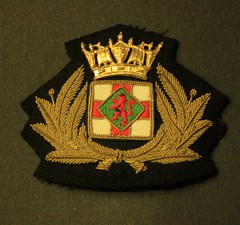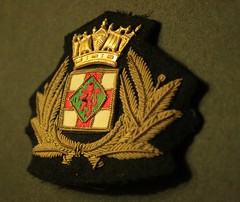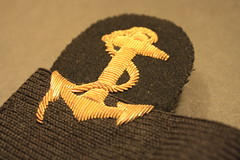Winter hat; navy blue wool with wicker frame, ½-in. wide. gold bullion chinstrap and two 22½-ligne gilt cap screws. (note: if strap is ¼-in., hat would be that of a warrant officer).
Circa Second World War.
It is one thing to collect, and another to actually know what one is collecting. In a previous post, I detailed some known fakes and fantasies, and mentioned a few print sources for the collector. As follows is a reference bibliography; I will keep running updates as articles and works of interest appear - some are followed by a link to a downloadable pdf.
References:
Rudy Basurto. "Insignia of America's Little Known Seafarers, 2nd Ed." Privately Printed, nd. pdf here.
Rudy Basurto. "Insignia of America's Little Known Seafarers, 3rd Ed. (edited and revised by Steve Soto and Cynthia Soto)." Privately Printed, 2008. pdf here.
Herbert Hillary "Sarge" Booker, 2nd. "Crow's Nest #1 (Summer 1992)." pdf here.
Herbert Hillary "Sarge" Booker, 2nd. "Crow's Nest #2 (Autumn 1992)." pdf here.
Herbert Hillary "Sarge" Booker, 2nd. "Crow's Nest #3 (Winter 1992)." pdf here.
Herbert Hillary "Sarge" Booker, 2nd. "Crow's Nest #4 (New Year's Special Issue - 1993)." pdf here.
Herbert Hillary "Sarge" Booker, 2nd. "Crow's Nest #5 (Summer 1993)." pdf here.
Herbert Hillary "Sarge" Booker, 2nd. "Crow's Nest #6 (Mid-Summer 1993)." pdf here.
Herbert Hillary "Sarge" Booker, 2nd. "Crow's Nest #7 (Autumn 1993)." pdf here.
Herbert Hillary "Sarge" Booker, 2nd. "Crow's Nest #8 (Special 1993 Encyclopedia Edition)." pdf here.
Herbert Hillary "Sarge" Booker, 2nd. "Crow's Nest #9 (Fall 1993)." pdf here.
Herbert Hillary "Sarge" Booker, 2nd. "Crow's Nest #10 (1994 New Year's Special)." pdf here.
Herbert Hillary "Sarge" Booker, 2nd. "Crow's Nest #11 (Spring 1994)." pdf here.
Herbert Hillary "Sarge" Booker, 2nd. "Crow's Nest #11 (Spring 1994 - The Issue That Never Was)." pdf here.
Herbert Hillary "Sarge" Booker, 2nd. "Crow's Nest #12 (Summer 1994)." pdf here.
Herbert Hillary "Sarge" Booker, 2nd. "Crow's Nest #13 (Fall 1994)." pdf here.
Herbert Hillary "Sarge" Booker, 2nd. "Specialty and Distinguishing Marks: U.S. Coast Guard, U.S. Maritime Service, U.S. Navy, and U.S. Public Health Service, 3rd Revision." Privately Printed, 1996. pdf here.
Dave Collar. "Insignia of the Army Transportation Service in World War II." ASMIC: The Trading Post October-December 1994: 29-43.
Dave Collar. "Insignia of the United States Maritime Service, World War II." ASMIC: The Trading Post April-June 1995.
Dave Collar. "Insignia of the United States Shipping Board." ASMIC: The Trading Post October-December 1996.
William K. Emerson. "Section XIII. The Army's Navy: Chapter Thirty-Six. Army Transport Service and Harbor Boat Service." Encyclopedia of United States Army Insignia and Uniforms.
Steve Soto and Cynthia Soto. "A collector's guide to the History, Uniforms and Memorabilia of the U.S. Merchant Marine and Army Transport Service during World War II." Privately Printed, 1996 (revised 2008).
Joseph J. Tonelli. Visor hats of the United States Armed Forces: 1930-1950.














































